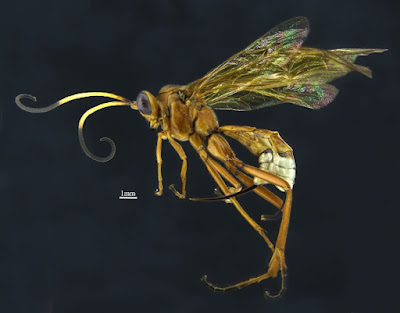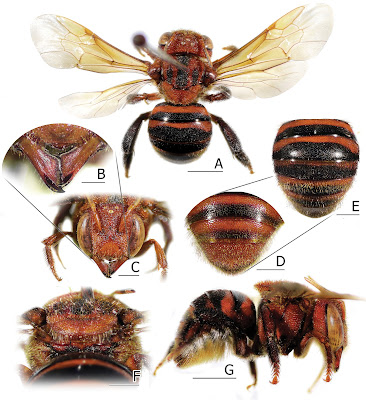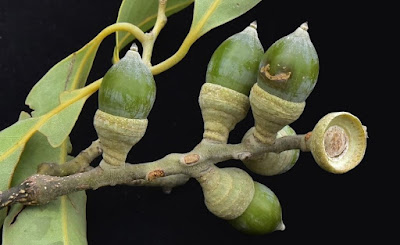[Most Recent Entries] [Calendar View]
Thursday, March 24th, 2022
| Time | Event | ||
| 3:12a | [Entomology • 2022] Exetastes andensis & E. tullu • Two New Species of Exetastes (Hymenoptera: Ichneumonidae: Banchinae) from the Peruvian Andes
ABSTRACT Two new species of Exetastes Gravenhorst, 1829 from the Peruvian Andes are described and illustrated: E. andensis sp. nov. and E. tullu sp. nov. Presently, 38 species of Exetastes have been recorded in the Neotropical region. Our discoveries are the first records of the genus in Peru and the Andean region. Keywords: Banchini, Darwin wasps, parasitoid, Peru, Cloud Forest, Neotropics, mountains Alexey Reshchikov and Mabel Alvarado. 2022. Two New Species of Exetastes (Hymenoptera: Ichneumonidae: Banchinae) from the Peruvian Andes. European Journal of Taxonomy. 806(1), 52–63. DOI: 10.5852/ejt.2022.806.1701 | ||
| 5:08a | [Entomology • 2021] Anthidiellum (Ranthidiellum) phuchongensis • The Resin Bee Subgenus Ranthidiellum in Thailand (Hymenoptera: Megachilidae, Anthidiini): Nesting Biology, Cleptoparasitism by Stelis, and New Species
Abstract Resin bees of the subgenus Ranthidiellum, are rare and endemic to Southeast Asia. These bees are known to construct resinous entrance tubes to their nests. Here, the new species Anthidiellum (R.) phuchongensis sp. nov. is described along with a description of its nest collected from Phu Chong Na Yoy National Park, Ubon Ratchathani Province, Thailand. In addition, the bee cleptoparasite, Stelis (Malanthidium) flavofuscinular sp. nov., and the male of A. (R.) ignotum Engel, 2009, are described for the first time. A key to Ranthidiellum species is also provided. Keywords: Anthidiellum, Malanthidium, pollinator, systematics, taxonomy, wool carder bee Anthidiellum (Ranthidiellum) phuchongensis Nalinrachatakan & Warrit, sp. nov. Diagnosis: This new species resembles Anthidiellum ignotum Engel, 2009 in overall appearance, but differs by its dark orangish to reddish integument; facial marks restricted on the frons; black apical bands on all terga except T6, making T6 clearly orangish (Fig. 3D), whereas all other females of Ranthidiellum species come with black T6; black hairs on T2, T3, and lateral of T1 and T4; black hind coxa on the upper part with a small black patch around its lower part. Midleg and hindleg covered with black hairs on tibia and basal part of tarsi, making these legs superficially brownish; male S4 gradulus complete. Etymology: The name is given to the Phu Chong Na Yoy National Park, Ubon Ratchathani Province, where both the holotype and paratype were collected. ผึ้งหยาดอำพันภูจอง Floral association: Dipterocarpaceae. It is evident that A. phuchongensis utilized resins of Dipterocarpus obtusifolius Teijsm. ex Miq., a dominant plant in the area. Bee kleptoparasites: Stelis flavofuscinular sp. nov. (see below). Genus Stelis Panzer, 1806 Subgenus Malanthidium Pasteels, 1969 Malanthidium Pasteels, 1969: 26. Type species: Anthidium malaccense Friese, 1914, by original designation. Stelis (Malanthidium) flavofuscinular Nalinrachatakan & Warrit, sp. nov. Diagnosis: With only males known, Stelis flavofuscinular is distinct from its only known congener, S. malaccensis from Malaysia, as follows: head overall black, with yellow paraocular mark reaching close to the top of eyes, and narrow mark restricted close to apical area of clypeus; antennal scape black; Mesosoma overall black except yellow on postero-lateral hook of axilla; T1–T5 with large yellow strike band, with little median disruption that is pronounced more on rear metasomal segments; T6 with lateral yellow dots; S2–S4 with distinct median patch of long white hairs, while lacking black midapical comb. S4 and genitalia as in Fig. 7G. Etymology: The word flavo means “yellow”, while fuscinular means “hook”. Thus, the specific epithet, flavofuscinular, principally refers to the yellow postero-lateral axilla hook of male bees that contrasts with its overall black mesosoma. ผึ้งบุษราคัม Bee host: Anthidiellum phuchongensis sp. nov. (see above). It is possible that S. flavofuscinular sp. nov. may also be a cleptoparasite of other Megachile species that are also frequently encountered in the PCNYNP area. Kasparek (2015) suggested that the hosts of Stelis species are mainly members of Megachilinae, and some Stelis species have a wide range of hosts. Pakorn Nalinrachatakan, Prapun Traiyasut, Anupong Khongnak, Manop Muangkam, John S. Ascher and Natapot Warrit. 2021. The Resin Bee Subgenus Ranthidiellum in Thailand (Megachilidae, Anthidiini): Nesting Biology, Cleptoparasitism by Stelis, and New Species. ZooKeys. 1031: 161-182. DOI: 10.3897/zookeys.1031.57836 การค้นพบผึ้งชนิดใหม่ของโลกจากอุทยานแห่งชาติภูจองนายอย จังหวัดอุบลราชธานี ผึ้งหยาดอำพันภูจอง (Phujong Resin Bee) หรือ Anthidiellum (Ranthidiellum) phujongensis n. sp. เป็นผึ้งเฉพาะถิ่น อุทยานแห่งชาติภูจองนายอย และพบได้เพียงที่เดียวเท่านั้นบนโลก โดยอาศัยอยู่ในรังบนผาดิน ใช้ยางไม้สร้างรังและปากทางเข้า ภายในรังจะมีผึ้งตัวเมียเพียงตัวเดียวที่ท พร้อมกันนี้ทีมผู้วิจัยยังได้ค้นพบผึ้งปรส | ||
| 8:11a | [Botany • 2022] Begonia normaaguilariae (Begoniaceae, sect. Baryandra) • A New Species from the Limestone Forests of Samar Island, Philippines
Abstract Begonia normaaguilariae, a new Philippine Begonia species from the section Baryandra is described and illustrated herewith. It bears a superficial resemblance to B. biliranensis with a repand leaf margin, and obovoid anther shape. However, the new species is unique in reference to its conduplicate stipule, longer capsule pedicel length, and completely glabrous rhizome, petioles, and leaves. Begonia normaaguilariae was only recorded from the limestone forests of Samar Island Natural Park, Samar Island, Philippines. Following the Red List criteria of the IUCN Standards and Petitions Subcommittee, B. normaaguilariae is hereby proposed as Critically Endangered. Keywords: eudicots, karst landscape, Malesia, taxonomy Diagnosis:— Begonia normaaguilariae bears a superficial resemblance to B. biliranensis in reference to the shape of leaf foliage in having asymmetric leaf blades with glabrous adaxial surface, white-puncticulate abaxial surface, with inequilateral cordate base, repand or repand-lobed margins and acuminate apex. The new species, however is distinguished by having stipules with a conduplicate stipule towards the acute to acuminate (vs acuminate) apex, longer (190–203 vs 110–180 mm) petioles, and entirely glabrous (vs brown–setose on nerves) abaxial leaf surface and it has much larger overall size of staminate and pistillate flowers. Distribution and Ecology: — Begonia normaaguilariae is known only from the type locality, Samar Island Natural Park, Municipality of Paranas, Samar Island. It was observed to grow under shaded and moist environments. Furthermore, it was recorded to thrive along the trail on soil but more prominently on limestone rock crevices. The fibrous roots are covered with dried forest litter. Etymology: — The specific epithet “normaaguilariae” is in honor of the late Professor Norma O. Aguilar, the former professor of plant systematics and head of the Plant Biology Division, Institute of Biological Sciences, University of the Philippines Los Baños (UPLB). Her taxonomic contributions on the plant families Poaceae and Fabaceae, have inspired many botanists to follow her stead. Marjorie D. Delos Angeles, Rosario R. Rubite, Kuo-Fang Chung, Inocencio E. Buot Jr., Danilo N. Tandang. 2022. Begonia normaaguilariae (Section Baryandra, Begoniaceae), A New Species from the Limestone Forests of Samar Island, Philippines. Phytotaxa. 541(1); 49-56. DOI: 10.11646/phytotaxa.541.1.4 | ||
| 9:22a | [Botany • 2022] Lithocarpus eiadthongii (Fagaceae) • A New Stone Oak Species from southern Thailand
Abstract A new species of the genus Lithocarpus, L. eiadthongii, from southern part of Thailand is described and illustrated. Its colour photographs are also provided and its conservation status is assessed. The new species is superficially similar to L. melataiensis, L. pusillus and L. vuquangensis in terms of leaf and fruit size. Notwithstanding, it differs from the three species in several aspects e.g. leaf apex, leaf blade covering, cupule stalk, cupule size, nut size and nut enclosure. Keywords: Asia, conservation, diversity, oak, tree, Eudicots Lithocarpus eiadthongii Sinbumr., Rueangr. & Sungkaew, sp. nov. Diagnosis:— Lithocarpus eiadthongii is superficially similar to L. melataiensis , L. pusillus and L. vuquangensis. In terms of leaf characters, it may look like L. vuquangensis, but it is, however, much different from the latter in terms of fruit characters (having cupule size of 4−7 mm high by 8−13 mm across; cupule surface with (5)6−9 lamellae; nut size of 0.8−1.5 cm across; nut basal scar of 4−8 mm across in L. eiadthongii vs cupule size of ca 14 mm high by ca 18 mm across; cupule surface with 4−5 lamellae; nut size of 2.1−2.4 cm across; nut basal scar of ca 11 mm across in L. vuquangensis). Whilst, in terms of fruit characters, it may look similar to L. melataiensis and L. pusillus, but L. eiadthongii differs from the latter two in having a stalked cupule of 3−6 mm long (vs sessile cupule in L. melataiensis vs sessile to stalked cupule of 2−3 mm long in L. pusillus. Moreover, in terms of leaf characters, L. eiadthongii is much different from the latter two in having a leaf acumen of 3−10 cm long and leaf undersurface with sparsely white to creamy-white waxy to glabrous (vs leaf acumen of 15−22 mm long and leaf undersurface with densely yellowish brown tomentose, sometimes with simple hairs in L. melataiensis vs leaf acumen of 10−30 mm long and leaf undersurface with densely greyish brown tomentose by adpressed, minute, stellate hairs in L. pusillus) ( Table 1). Etymology:—The specific epithet eiadthongii is named in honour of a well-known Thai dendrologist, Associate Professor Wichan Eiadthong who specialized in many families of Thai flora including Fagaceae (Eiadthong, 1993) . Vernacular:— Ko look eiad (Thai - ก่อลูกเอียด), meaning an oak tree with small fruit. Ecology and distribution:— Currently, it is only known from peninsular Thailand; in Namtok Ngao National Park and Klong Naka Wildlife Sanctuary of Ranong province and Si Phang-Nga National Park of Phang-Nga province. They grow in the co-dominant and intermediate layers of the evergreen forest canopy, particularly along the hillsides, between 60 m and 260 m elevation. Aroon Sinbumroong, Sukid Rueangruea, Atchara Teerawatananon and Sarawood Sungkaew. 2022. Lithocarpus eiadthongii (Fagaceae), A New Stone Oak Species from southern part of Thailand. Phytotaxa. 541(1); 73-78. DOI: 10.11646/phytotaxa.541.1.7 ก่อลูกเอียด Lithocarpus eiadthongii Sinbumr., Rueangr. & Sungkaew โดยคำระบุชนิด eiadthongii ตั้งชื่อเพื่อเป็นเกียรติแก่ ผศ. ดร.วิชาญ เอียดทอง อดีตอาจารย์ผู้ล่วงลับ ภาควิชาชีววิทยาป่าไม้ คณะวนศาสตร์ มหาวิทยาลัยเกษตรศาสตร์ ผลงานของท่านนับเป็นคุณูปการอันใหญ่หลวงแก news.dnp.go.th/news/14817 | ||
| 5:21p | [Paleontology • 2022] Tomlinsonus dimitrii • A New Marrellomorph Arthropod from southern Ontario: A Rare Case of Soft-tissue Preservation on A Late Ordovician Open Marine Shelf
Abstract Ordovician open marine Lagerstätten are relatively rare and widely dispersed, producing a patchy picture of the diversity and biogeography of nonmineralized marine organisms and challenging our understanding of the fate of Cambrian groups. Here, for the first time, we report soft-bodied fossils, including a well-preserved marrellomorph arthropod, fragmentary carapaces, and macroalgae, from the Late Ordovician (Katian) Upper Member of the Kirkfield Formation near Brechin, Ontario. The unmineralized elements and associated exceptionally preserved shelly biota were entombed rapidly in storm deposits that smothered the shallow, carbonate-dominated shelf. The marrellomorph, Tomlinsonus dimitrii n. gen. n. sp., is remarkable for its ornate, curving cephalic spines and pair of hypertrophied appendages, suggesting a slow-moving, benthic lifestyle. Reevaluation of marrellomorph phylogeny using new data favors an arachnomorph affinity, although internal relationships are robust to differing outgroup selection. Clades Marrellida and Acercostraca are recovered, but the monophyly of Marrellomorpha is uncertain. The new taxon is recovered as sister to the Devonian Mimetaster and, as the second-youngest known marrellid, bridges an important gap in the evolution of this clade. More generally, the Brechin biota represents a rare window into Ordovician open marine shelf environments in Laurentia, representing an important point of comparison with contemporaneous Lagerstätten from other paleocontinents, with great potential for further discoveries. Joseph Moysiuk, Alejandro Izquierdo-López, George E. Kampouris and Jean-Bernard Caron. 2022. A New Marrellomorph Arthropod from southern Ontario: A Rare Case of Soft-tissue Preservation on A Late Ordovician Open Marine Shelf. Journal of Paleontology. First View, 1 - 16. DOI: 10.1017/jpa.2022.11 |
| << Previous Day |
2022/03/24 [Calendar] |
Next Day >> |






































